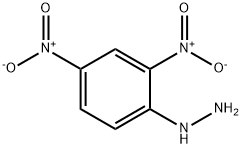2,4-디나이트로페닐히드라진
|
|
2,4-디나이트로페닐히드라진 속성
- 녹는점
- 197-200 °C (lit.)
- 끓는 점
- 335.43°C (rough estimate)
- 밀도
- 0.843 g/mL at 20 °C
- 굴절률
- n
20/D 1.374
- 인화점
- 14 °C
- 저장 조건
- 2-8°C
- 용해도
- 50% 황산: 10mg/mL, 투명, 무색
- 산도 계수 (pKa)
- 12.1(at 25℃)
- 물리적 상태
- 크리스탈
- 색상
- 빨간색
- pH 범위
- Yellow (11.0) to brown (12.5)
- 수용성
- 약간 용해됨
- Merck
- 14,3283
- BRN
- 615586
- 안정성
- 젖으면 안정하지만 건조하면 폭발합니다. 건조하면 충격에 민감할 수 있습니다. 가연성이 높습니다. 강한 산화제와 호환되지 않습니다.
- 주요 응용
- 연료전지, 미생물검출, 항균제, 급성 및 만성 간염치료, 부인병, 심혈관질환, 뇌혈관질환 치료
- InChIKey
- HORQAOAYAYGIBM-UHFFFAOYSA-N
- CAS 데이터베이스
- 119-26-6(CAS DataBase Reference)
안전
- 위험 및 안전 성명
- 위험 및 사전주의 사항 (GHS)
| 위험품 표기 | F,Xn | ||
|---|---|---|---|
| 위험 카페고리 넘버 | 1-11-22-40-2001/11/22 | ||
| 안전지침서 | 35-48A-45-36/37-16 | ||
| 유엔번호(UN No.) | UN 3380 4.1/PG 1 | ||
| WGK 독일 | 3 | ||
| RTECS 번호 | MV3325000 | ||
| F 고인화성물질 | 8 | ||
| 위험 등급 | 4.1 | ||
| 포장분류 | II | ||
| HS 번호 | 29280000 | ||
| 기존화학 물질 | KE-11951 |
2,4-디나이트로페닐히드라진 C화학적 특성, 용도, 생산
개요
DNP는 활성 체세포에서 양성자 이온 엽 성의 역할을한다. 프로톤 이오 노 포어 (proton ionophore)는 생물체의 세포막을 가로 지르는 수소 양이온 (proton)을 왕복시키는 능력을 가진 작용제를 지칭합니다. DNP는 미토콘드리아 또는 엽록체 막 전체에 양성자 기울기를 분산 시키며 결과적으로 살아있는 세포가 아데노신 삼인산 (ATP) 화학 에너지의 대부분을 만들기 위해 사용하는 양성자 동력을 붕괴시킵니다. 양성자 기울기는 ATP를 생성하는 데 사용되는 에너지가 아니라 열의 형태로 에너지를 잃습니다.용도
DNP원시 파우더는 살아있는 세포막에서 일어나는 다른 수송 과정 중에서 화학적 탐식 생물 에너지 탐사에 정기적으로 사용되는 생화학 연구에서 매우 두드러집니다.폭발물로 사용되는 것 외에도이 화합물은 살충제, 사진 현상액, 목재 보존제 및 제초제로도 유용했습니다.개요
2,4-Dinitrophenylhydrazine (abbreviated 2,4-DNP for short) is the chemical compound C6H3 (NO2) 2NHNH2, and it is often used to qualitatively test for carbonyl groups associated with aldehydes and ketones. The hydrazone derivatives can also be used as evidence toward the identity of the original compound. It is relatively sensitive to shock and friction; it is a shock explosive, so care must be taken with its use. To reduce its explosive hazard, it is usually supplied wet.2,4-Dinitrophenylhydrazine is a compound with a benzene ring, two Nitro groups, and a hydrazine (two nitrogen atoms bonded directly to each other) functional group. It is used as a Brady's reagent to test the existing of a ketone or aldehyde.
화학적 성질
white to light yellow crystal powde용도
2,4-Dinitrophenylhydrazine is known was Brady's reagent, a substituted hydrazine that is often used for qualitative testing of carbonyl groups associated with aldehydes and ketones.정의
ChEBI: 2,4-dinitrophenylhydrazine is a C-nitro compound that is phenylhydrazine substituted at the 2- and 4-positions by nitro groups. It has a role as a reagent. It is a member of phenylhydrazines and a C-nitro compound.일반 설명
2,4-Dinitrophenylhydrazine (DNPH), a hydrazine derivative, is a potential mutagenic agent. Its molecular and crystal structure has been analyzed. The intra- and intermolecular hydrogen bonds in DNPH have been investigated by vibrational spectroscopic analysis. The mechanism of isothermal degradation of DNPH has been studied by differential scanning calorimetry (DSC).위험도
2,4-Dinitrophenylhydrazine [119-26-6] is a flammable solid, which must be kept moist and is harmful if swallowed, inhaled, or absorbed through the skin. Concentrated sulfuric acid [7664-93-9] is poisonous and corrosive. Its mist can cause severe burns to all body tissue. It may be fatal if swallowed or by skin contact. It is harmful if inhaled and may cause cancer. Ethanol [64-17-5] is flammable and should be kept from ignition sources. Eye and face protection, protective clothing, and gloves must be worn.Purification Methods
Crystallise DNPH from butan-1-ol, dioxane, EtOH, *C6H6 or EtOAc. The hydrochloride has m 186o (dec). [Beilstein 15 IV 380.]참고 문헌
1. SOME LIMITATIONS OF 2,4-DINITROPHENYLHYDRAZINE AS A REAGENT FOR CARBONYL GROUPS. DOI:10.1021/JO01226A0032. Linstromberg, W. W.; Baumgarten, H. E. Organic Experiments, 6th ed.; Houghton Mifflin: Boston, 2002; p 175. Shriner, R. L.; Hermann, C. K. F.; Morrill, T. C.; Curtin, D. Y.; Fuson, R. C. The Systematic Identification of Organic Compounds, 8th ed.; Wiley; Hoboken, NJ, 2004; pp 278–279.
3. An Improved Preparation of 2,4-Dinitrophenylhydrazine Reagent. DOI:10.1021/ED082P1310.2
2,4-디나이트로페닐히드라진 준비 용품 및 원자재
원자재
준비 용품
2,4-디나이트로페닐히드라진 관련 검색:
1,1-디페닐-2-피크릴하이드라이진 2,4-디나이트로페닐히드라진 나이트로벤젠 페닐히드라진 2,4-다이나이트로페놀 염산
CYCLOHEXANONE 2,4-DINITROPHENYLHYDRAZONE
BENZALDEHYDE 2,4-DINITROPHENYLHYDRAZONE
P-TOLUALDEHYDE 2,4-DINITROPHENYLHYDRAZONE
2,2-diphenyl-1-picrylhydrazyl
ACETONE 2,4-DINITROPHENYLHYDRAZONE
CROTONALDEHYDE (DNPH DERIVATIVE)
DNP-L-THREONINE
N-BUTYRALDEHYDE 2,4-DINITROPHENYLHYDRAZONE
FORMALDEHYDE 2,4-DINITROPHENYLHYDRAZONE
DNP-PLGMWSR
DNP-L-ISOLEUCINE
PROPIONALDEHYDE 2,4-DINITROPHENYLHYDRAZONE








